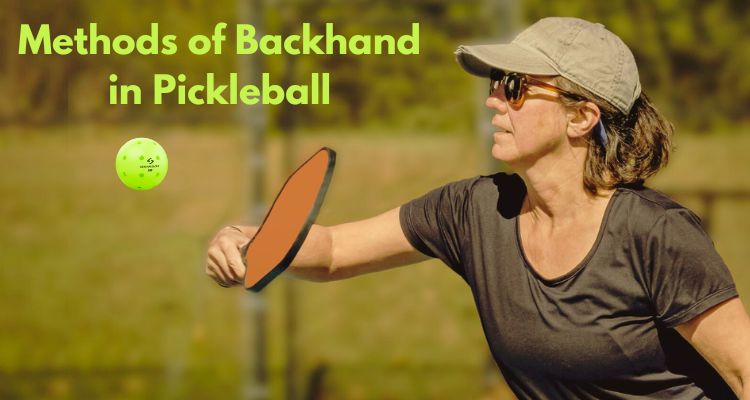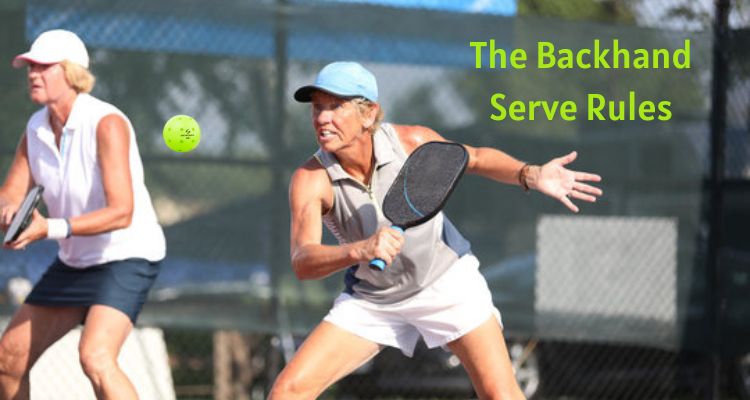Are you tired of using the same old backhand technique in pickleball? Ready to spice up your game and add some variety? Look no further! We’ve got you covered with this blog post.
Today, we’re going to dive deep into the world of backhand in pickleball. Whether you’re a beginner or a pro, there’s always room for improvement, so let’s get excited about all the amazing backhand shots out there!
What Is a Backhand in Pickleball?
In pickleball, the backhand stroke is when you hit the ball with the face of your paddle on the backside of your body. You can use either one or two hands for this shot. While the backhand is often used defensively due to its lack of power, it can be incredibly effective offensively if executed well.

There are several types of backhand in pickleball, each with its own advantages and disadvantages. One-handed strokes offer more accuracy and control, while two-handed shots provide more power. It’s all about finding the right balance!
Methods of Backhand in Pickleball
Let’s explore some different methods:
- One-Handed Backhand: This is the most common backhand technique used by recreational players. It’s a great starting point for beginners.
- Two-Handed Backhand: More advanced players often use this technique for its added power. It requires precise control for optimal results.
- Slice Backhand: A variation of the one-handed backhand, this technique involves adding a spin to the shot. It can be a game-changer!
- Topspin Backhand: Another variation of the one-handed backhand, this technique adds topspin to the shot, making it bounce differently when it lands. It’s all about adding that extra element of surprise!
What Are the Benefits of Backhand Serving?
Backhand in pickleball offer many advantages. First of all, they catch opponents off guard, as they are less common than forehand serves. This gives you a strategic edge over your competitors who may still be waiting for a forehand serve.
Furthermore, backhand serves allow for better control over the ball compared to forehand serves. They make it harder for opponents to return shots and keep them off-balance. Adding spin to your backhand serve can make it even more challenging for opponents to handle.
The Backhand Serve Rules
There are a few variations of the backhand serve in pickleball, but the most common is the underhand version. To execute this serve, grip the paddle with your non-dominant hand and make contact with an underhanded swing. Other variations, such as overhand and side-arm serves, have their specific rules.
Remember, when serving, stand behind the baseline on one side of the net and wait for your opponent to return the ball. Aim to strike the ball below net level, within the court boundaries, and diagonally towards your opponent’s court. By following these general guidelines, you’ll be able to execute a successful backhand serve with ease!

How to Hit a Backhand Serve in Pickleball?
There are two main types of backhand in pickleball: the one-handed backhand and the two-handed backhand. Each has its own unique benefits and drawbacks. The one-handed backhand offers more power and spin but can be more challenging to master. On the other hand, the two-handed backhand is easier to learn but may not have as much force or spin as the one-handed backhand.
For a successful one-handed backhand serve, start by positioning yourself so that your non-dominant hand is closest to the net. Toss the ball into the air and strike it with an overhand motion using your dominant hand. Snap your wrist at impact for that extra spin.
If you prefer an easier way to hit a backhand serve, try the two-handed grip. Position your hands on the paddle’s handle as if you were going to shake someone’s hand. Swing using both hands together in a synchronized motion. While this type of serve provides less power and spin, it’s more consistent and easier to execute.
FAQs
What is the Importance of Backhand Serve in Pickleball?
The backhand serve is an essential technique in pickleball. It allows you to hit the ball with the opposite side of your paddle when a forehand stroke isn’t possible. If executed correctly, it can be very successful. However, it’s best to use this maneuver strategically rather than overusing it and tiring yourself out.
How do I grip the pickleball paddle for a backhand serve?
There are two main grips for backhand serves: the continental grip and the Eastern forehand grip. The continental grip involves holding the paddle with your palm facing down and your thumb and first finger wrapped around the handle. The Eastern forehand grip requires holding the paddle with your palm facing up and your thumb and first finger wrapped around the handle.
How do I know if my backhand serve is legal?
A legal backhand serve must be hit below the waist and behind the non-volley zone line. The ball must clear the net by at least four inches. The specific rules may vary depending on the grip you use (continental or Eastern forehand).
What are some common faults with backhand serves?
Some typical faults with backhand serve include not hitting below the waist, not clearing the net, not hitting behind the non-volley zone line, or taking too long to hit the ball.
Conclusion
In conclusion, mastering the backhand shot in pickleball is crucial for players at all levels, offering a range of techniques that can significantly impact gameplay. Whether using a one-handed or two-handed grip, the backhand stroke allows for varied approaches—accuracy and control with the one-handed method, or power with the two-handed style.
Adding spin through slice or topspin backhands can introduce unpredictability to the shot. Backhand serves present a strategic advantage, catching opponents off guard and providing better ball control, making them harder to return. Ultimately, honing your backhand skills can give you a competitive edge, making you a proficient backhand player in the dynamic world of pickleball. Practice and dedication are key to achieving mastery in this essential aspect of the sport.




